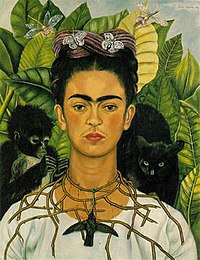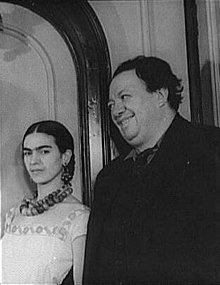Frida Kahlo

Frida Kahlo (July 61907 – July 13, 1954) was a Mexican painter of the indigenous culture of her country in a style combining Realism, Symbolism and Surrealism, an active Communist supporter, and wife of the Mexican muralist and cubist painter Diego Rivera.
Kahlo was noted for her unconventional appearance, declining to remove her facial hair (she had a small mustache and unibrow which she exaggerated in self portraits), and for her flamboyantly styled clothing, drawn largely from traditional Mexican dress.
Biography
Early life
Kahlo was born Magdalena Carmen Frieda Kahlo y Calderón in her parents' house in Coyoacán, which at the time was a small town on the outskirts of Mexico City. Her father, Guillermo Kahlo, (1872-1941) was born in Baden-Baden, Germany as Wilhelm Kahlo the son of the jeweller and goldsmith Jakob Heinrich Kahlo and his wife Henriette née Kaufmann, both of whom were ethnic Germans and Lutherans (although Frida had later incorrectly claimed that her father was Jewish).[1] Wilhelm Kahlo sailed to Mexico in 1891 at the age of 19 where he then changed his German forename for its Spanish equivalent, Guillermo. Her mother, Matilde Calderón y Gonzalez, was of primarily Amerindian descent mixed with Spanish. The young Frida suffered a bout of polio at age six, which left her right leg looking much thinner than the other. Still, with the feisty and brash personality that she kept throughout her life, she overcame her disability. In 1922, Kahlo was enrolled in the Preparatoria, one of the top schools in Mexico. She was one of only 35 girls. Kahlo also witnessed violent armed struggles in the streets of Mexico City as the Mexican Revolution took place. It was a moment that changed Kahlo's life.
In 1925, a trolley car collided with a bus Kahlo was riding; she suffered a broken spinal column, a broken collarbone, broken ribs, a broken pelvis, 11 fractures in her right leg, a crushed and dislocated right foot, and a dislocated shoulder. Also, an iron handrail had impaled her abdomen, piercing through her uterus. Because of the injuries to her pelvis and uterus, she was unable to carry a child to full-term without serious risks, a fact that took her a long time to accept. She survived her injuries and eventually regained her ability to walk, but she would have relapses of extreme pain which would plague her for life, often leaving her hospitalized and/or in bed for months at a time, agonized and miserable. Frida would undergo as many as thirty-five operations in her life as a result of the accident, mainly on her back and her right leg/foot.
Career as painter

After the accident, Kahlo turned her attention from a medical career to painting. Drawing on her personal experiences (her troubled marriage, her painful miscarriages, her numerous operations), her works are often shocking in their stark portrayal of pain. Fifty-five of her 143 paintings are self-portraits, often incorporating symbolic portrayal of her physical and psychological wounds. She was deeply influenced by indigenous Mexican culture, which surfaced in her paintings' bright colors, dramatic symbolism, and unapologetic rendering of often harsh and gory content.
Although Kahlo's work is sometimes classified as surrealist and she did exhibit several times with European surrealists, she never considered herself a surrealist. Her preoccupation with female themes and the figurative candor with which she expressed them made her something of a feminist cult figure in the last decades of the 20th century.
Stormy marriage

Her paintings attracted the attention of fellow artist Diego Rivera, whom she later married.
They were often referred to as "The Elephant and the Dove" due to their difference in size (Frida's mother, who did not like Diego, came up with this description of them). When they first married, he was 42, 6 ft 1 in. (1.86 m) tall, and 300 pounds (136 kg); she was 22, 5 ft 3 in. (1.6 m) and 98 pounds (44.5 kg).
Their marriage was a stormy one, largely due to Diego's weakness for extramarital flings. Their notoriously fiery temperaments also played a part in the storminess, and both had numerous extramarital affairs (Frida was outraged when she found that Diego had an affair with her younger sister, Cristina Kahlo).
Frida did not hide from Diego the fact that she was bisexual; Diego tolerated her relationships with women (among them actress Josephine Baker) better than her relationships with men, the latter of which made him fiercely jealous. The couple divorced, but remarried in 1940, although their union was no less rocky.
Late years

Active Communist sympathizers, Kahlo and Rivera befriended Leon Trotsky as he sought political asylum from Joseph Stalin´s regime in The Soviet Union. Initially, Trotsky lived with Rivera and then at Frida's home where he and Frida allegedly had an affair. Trotsky and his wife then moved to another house in Coyoacán where Trotsky was later assassinated. Sometime after Trotsky's death, Frida denounced her former friend and praised the Soviet Union under Stalin. She spoke favorably of Mao, calling China "the new socialist hope".
Kahlo died on July 13, 1954, supposedly of a pulmonary embolism. She had been ill throughout the previous year and had had a leg amputated owing to gangrene. However, an autopsy was never performed and many are convinced she committed suicide. A few days before her death she had written in her diary: "I hope the leaving is joyful; and I hope never to return."
The pre-Columbian urn holding her ashes is on display in her former blue home La Casa Azul in Coyoacán, today a museum housing a number of her works of art.
Character
Despite her life of suffering and pain, Frida Kahlo was a vibrant, extroverted character whose everyday speech was filled with profanities. She had been a tomboy in her youth and carried her fervor throughout her life. She was a strong smoker, drank liquor (especially tequila) in excess, was openly bisexual, sang off-color songs, and told equally ribald jokes to the guests of the wild parties that she hosted.
Films
A biographical documentary containing archival footage, entitled Frida Kahlo, was released in 1982 in Germany.
In 1984 director Paul Le Duc released the film Frida, naturaleza viva, which stars Ofelia Medina as Frida Kahlo.
In 2002, Miramax released a motion picture titled Frida, starring Salma Hayek in the title role.
In 2005, director Natalia Nazarova, from Russia, released a short experimental documentary portrait entitled "Frida vs. Frida", revolving around Kahlo's many relationships including Diego Rivera and Leon Trotsky. The film has been screened at many film festivals, including the Ann Arbor Film Festival. blah blah
External links
Frida Kahlo
- The Life and Art of Frida Kahlo
- Smithsonian Biography November 2002
- Gallery of Frida Kahlo's work
- A visit to La Casa Azul
- Frida Kahlo – Biography in German
- Tate Modern exhibition, 2005
- Frida's House, a yahoo group
- Frida Kahlo and her contemporary thoughts
- Frida Kahlo 1907-1954
- Frida by Kahlo
- Art Cyclopedia
- Frida (2002 film) at IMDb
- fridasays | a Frida-inspired blog
- Frida Kahlo Pain in Contemporary Art | In Psikeba Magazine
References
- Fuentes, C. (1998). Diary of Frida Kahlo. Harry N. Abrams (March 1, 1998). ISBN 0810981955.
- Gonzalez, M. (2005). Frida Kahlo – A Life. Socialist Review, June 2005. Retrieved from http://www.socialistreview.org.uk/article.php?articlenumber=9436
- Guardian Unlimited: Arts Galleries: Frida Khalo. Exhibition at Tate Modern, June 9 – October 9 2005. The Guardian,Wednesday May 18, 2005. Retrieved May 18, 2005 from http://www.guardian.co.uk/arts/gallery/0,8542,1424416,00.html
- Herrera, H. (2002). Frida : A Biography of Frida Kahlo. Perennial (October 1, 2002). ISBN 0060085894.
- Turner, C. (2005) Photographing Frida Kahlo. The Guardian, Wednesday May 18, 2005. Retrieved May 18, 2005 from http://www.guardian.co.uk/arts/features/story/0,11710,1486443,00.html
- Zamora, M. (1995). The Letters of Frida Kahlo: Cartas Apasionadas. Chronicle Books (November 1, 1995). ISBN 0811811247.
